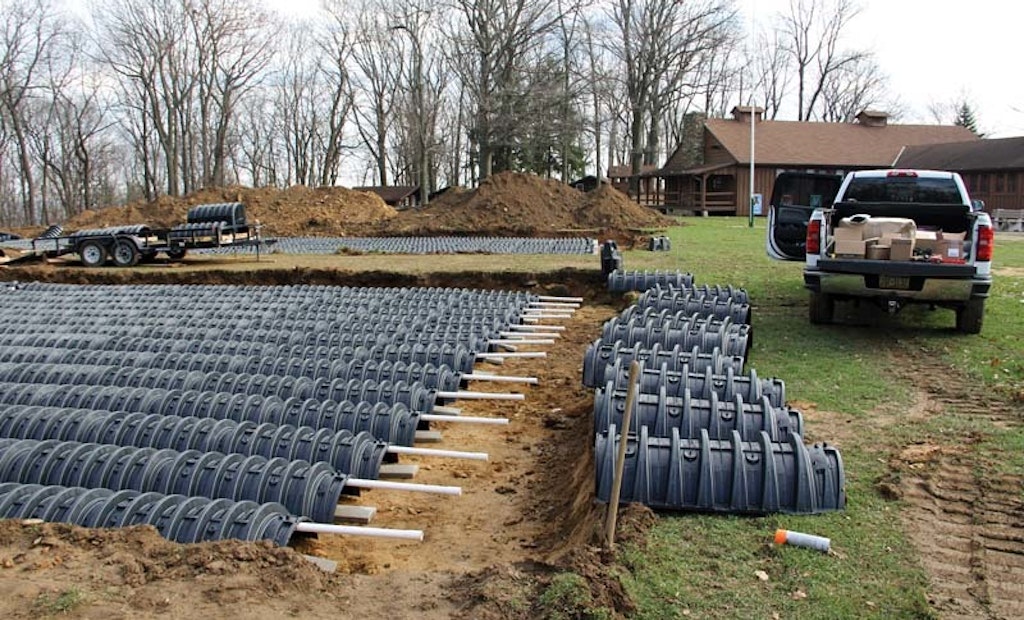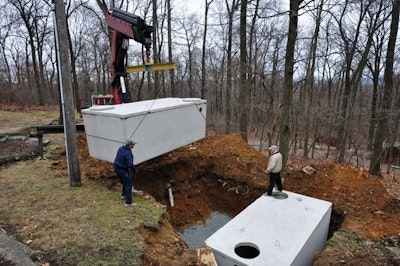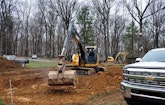
Interested in Pumps?
Get Pumps articles, news and videos right in your inbox! Sign up now.
Pumps + Get AlertsThe South Mountain YMCA Camp in Reinholds, Pennsylvania, wanted to double the size of its 200-seat dining hall and increase bathroom facilities from two to 18 toilets in the Wigwam Building. The latter has a recreation hall with lavatories on the ground floor and an auditorium on the upper level.
Dale Kuntzman, director of facilities, hired consulting sewage enforcement officer Roger Lehmann of All County & Associates to upgrade the onsite system. Before his involvement, however, the municipal SEO had chosen the new absorption area — the camp’s multipurpose activities field.
“I was extremely concerned with soil compaction limiting the air exchange into the drainfield,” says Lehmann. “In addition, the camp was essentially closed from October to March, so the system had to start up fast in spring.” His design divided the drainfield into two zones, enabling one to be inactive during winter. For the drainfield, he chose Infiltrator Water Technologies chambers because they facilitate airflow.
“This system is no different from single-family home systems, just larger,” says Lehmann. “There were no design challenges, only a cost versus benefit analysis of the various system types.” Jim Mack of Jim Mack Excavating in Hereford, Pennsylvania, won the installation bid.
Site conditions
Soils are loam to channery with a percolation rate of 12 minutes per inch. The seasonal high water table is 72 inches below grade.
System components
Anticipating possible additions to the dining hall, Lehmann designed the system to treat 8,500 gpd. Major components are:
Wigwam
- Three 2,000-gallon septic tanks in series (Single-compartment tanks by Monarch Precast Concrete Corp.)
- 2,000-gallon lift station with Model 3885 1/2 hp pump (Goulds Water Technology, a Xylem brand)
Dining hall
- 1,000-gallon 72-inch-diameter grease interceptor, traffic rated
- Two 3,000-gallon septic tanks in series
- Two 2,000-gallon septic tanks in series
- 6,000-gallon dose tank (three 2,000-gallon tanks connected in parallel) with duplex alternating 3887BHF 2 hp Goulds pumps
- 560 Quick4 standard chambers (Infiltrator Water Technologies)
- 2,408 feet of 1.5-inch Schedule 40 PVC laterals
- 20 4-inch Schedule 40 PVC vented inspection ports
- Two control panels (Aquaworx by Infiltrator)
System operation
Effluent from the Wigwam septic tanks flows through a 4-inch pipe to the lift station, then the on-demand pump sends 200 gallons at 20 gpm 190 feet through 2-inch PVC pipe to the dose tank below the dining hall.
A 4-inch pipe connects the dining hall kitchen to the grease interceptor. Lavatory wastewater flows through a 4-inch pipe to the four septic tanks connected in series, then effluent enters the dose tank. Dedicated on-demand pumps discharge 982 gallons at 182 gpm 216 feet through the 3-inch delivery line to the 2-inch manifold.
The manifold doses two 42- by 82-foot zones in the 6,888-square-foot drainfield. Each zone has 28 42-foot laterals hung in chambers, with 14 laterals per side. Effluent disburses through five 1/4-inch orifices per 1 1/5-inch pipe, while inspection ports ensure continuous air exchange.
Installation
Site preparation involved cutting down 15 mature trees growing in tank locations. Mack, his son, Loren, and son-in-law, Leil Ehst, pulled and disposed of the stumps, then crushed and filled the existing septic tank after it was pumped.
The driver from Monarch Precast delivered the tanks over four days. “I had specified multiple 2,000-gallon single-compartment tanks set in series because they were cheaper than 4,000- or 6,000-gallon tanks,” says Lehmann. “The grease interceptor is circular because grease can sometimes collect in the corners of rectangular tanks.”
The crew set the pump tanks first because the delivery truck had to park in those locations to lower the septic tanks. Ehst used a John Deere 135G excavator to dig most of the holes, and a Caterpillar 305 mini-excavator for tighter areas. The 3,000-gallon tanks came in two pieces. “We glued them together, but weren’t required to test for watertightness,” says Mack.
After installing the Wigwam tanks, Ehst trenched the 2-inch discharge pipe from the Wigwam pump tank across two asphalt driveways to the dining room pump tank. To protect the pressurized line at these locations, Loren Mack sleeved it inside 3-inch PVC pipe extending 5 feet beyond each side of the drives.
Ehst removed 12 inches of soil for the drainfield. “There was enough soil mixed with the rocks to make leveling the bed very simple,” says Jim Mack.
Laying the pipe and chambers was straightforward and uncomplicated. “If you can assemble Legos, you can install these chambers,” says Mack. “We completed both zones, pressurized them to test for leaks, and backfilled all in one day.” Once the area grew grass, children returned to play soccer, football and baseball on the athletic field.
Maintenance
The camp’s maintenance crew will follow Lehmann’s recommendation to inspect the tanks, pumps and electrical connections and hire a service provider to clean the tanks every two to three years.









